Harman Back On Top In Southeast
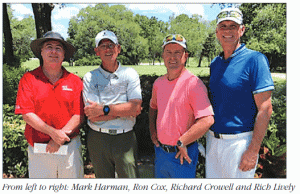 Mark Harman made a statement that he is still a force to be reckoned with at GlenLakes Country Club in Weeki Wachee, Florida, this past May. The reigning World Cup champion from Ridgeland, South Carolina, set a Southeast Region Championship scoring record of seven under par to best Ron Cox of Henderson, Tennessee, by five shots. Richard Crowell from Pensacola, Florida, and Rich Lively of Rockledge, Florida, took third and fourth, grabbing the balance from the $1,200 purse. Thanks goes out to GlenLakes head pro Tom McCrary, who has hosted us for several years.
Mark Harman made a statement that he is still a force to be reckoned with at GlenLakes Country Club in Weeki Wachee, Florida, this past May. The reigning World Cup champion from Ridgeland, South Carolina, set a Southeast Region Championship scoring record of seven under par to best Ron Cox of Henderson, Tennessee, by five shots. Richard Crowell from Pensacola, Florida, and Rich Lively of Rockledge, Florida, took third and fourth, grabbing the balance from the $1,200 purse. Thanks goes out to GlenLakes head pro Tom McCrary, who has hosted us for several years.


 USGTF member Walt Abraham, head golf coach of Athenian High School in Danville, California, led his squad to the BCL-East league round-robin regular season title and also the league post-season tournament title. The team finished 9-1 in match play and next heads to the Division 2 championship tournament. The league title marks the seventh time in Abraham’s 11 seasons as head coach that Athenian has taken that honor. Athenian fields a young squad of three freshmen, one sophomore and two juniors, with three players earning all-league honors.
USGTF member Walt Abraham, head golf coach of Athenian High School in Danville, California, led his squad to the BCL-East league round-robin regular season title and also the league post-season tournament title. The team finished 9-1 in match play and next heads to the Division 2 championship tournament. The league title marks the seventh time in Abraham’s 11 seasons as head coach that Athenian has taken that honor. Athenian fields a young squad of three freshmen, one sophomore and two juniors, with three players earning all-league honors. 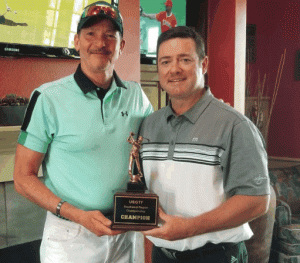 Cole Golden shot an opening round 69 against a strong field that featured several current and past USGTF champions at a windy Ridgeview Ranch Golf Course, which hosted the USGTF Southwest Region Championship May 4-5 in Plano, Texas. Tough, tricky greens and somewhat wet conditions after several days of wet weather had hit Texas earlier in the week greeted the competitors. Southwest Region director Bruce Sims and Master Lee carded 76 the first day, while Brent Davies and Chris Tyner shot 77. Grant Gulych, Jeff Kennedy, and D.B. Merrill came in with 78.
Cole Golden shot an opening round 69 against a strong field that featured several current and past USGTF champions at a windy Ridgeview Ranch Golf Course, which hosted the USGTF Southwest Region Championship May 4-5 in Plano, Texas. Tough, tricky greens and somewhat wet conditions after several days of wet weather had hit Texas earlier in the week greeted the competitors. Southwest Region director Bruce Sims and Master Lee carded 76 the first day, while Brent Davies and Chris Tyner shot 77. Grant Gulych, Jeff Kennedy, and D.B. Merrill came in with 78.
 By Graham Lewis, USGTF Teaching Professional Townsend, Georgia
By Graham Lewis, USGTF Teaching Professional Townsend, Georgia
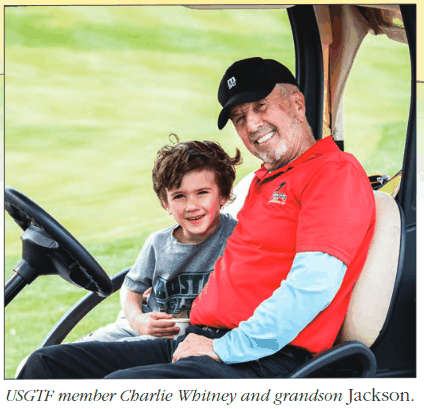
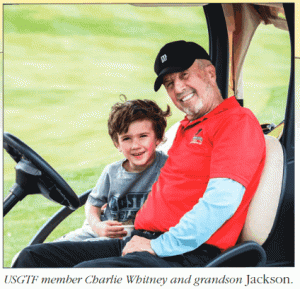 What are the first memories that you have of golf? If you started the game as a kid, they probably have to do with a family member – usually a parent – who introduced the game to you. Many golfers look back on those days with great fondness and nostalgia.
There is no better family sport than golf. Four family members can all play in the same group, something that is difficult to do in other sports. You can indeed do the same thing in tennis if you’re playing doubles, but unless the skill level is relatively similar among the four, it can make for a difficult time. Since golf, of course, doesn’t have other players affecting your playing of the game, it doesn’t matter if there is a skill disparity, even a great one, among those in the same group.
Golf also has an amount of down time that others sports do not offer. In tennis, there is constant action. In bowling, there is always someone rolling the ball down the lane. But in golf, most of the time is spent walking or riding to the next shot, so there is ample time for conversation and bonding. Some of the best friendships golfers have were formed on the golf course. Indeed, it’s not uncommon for golfers to have mainly or only golfers as friends.
The game also tends to lend itself to easy conversation that may not be found in other venues. Those who are parents know how tough it is sometimes to have conversations with their children as they get older, especially teenagers. But for some reason, conversation while playing golf seems to come naturally for most participants.
It has been said countless times that golf is also a metaphor for life. A well-known adageis that if you want to truly get to know a person’s character, play 18 holes of golf with them. It is the rare person who changes the character and behavior they exhibit outside the course once they step onto the first tee.
Life lessons can also be imparted to our younger family members as they play the game. Perhaps a child is having a tough time that day on the course and they feel like quitting. Teaching them to persevere on the course is a good lesson that can carry them through life. Let’s face it – although we say golf is fun, it’s also difficult to excel at. If someone wants to play scratch golf or better, they have to put in countless hours over countless days over countless years, unless they are some sort of athletic freak. Golf can teach our children the valuable life values of determination and perseverance, and keeping a calm mind when things go awry.
Although the game can understandably lend itself to temper tantrums and worse, we must always remember that unless the game directly affects our well-being as a professional golfer, it’s only a game to the rest of us. How we do doesn’t affect our lives in any way, shape, or form, and it’s important to keep this perspective. These are the things that our younger family members, and sometimes even ourselves, should take to heart.
What are the first memories that you have of golf? If you started the game as a kid, they probably have to do with a family member – usually a parent – who introduced the game to you. Many golfers look back on those days with great fondness and nostalgia.
There is no better family sport than golf. Four family members can all play in the same group, something that is difficult to do in other sports. You can indeed do the same thing in tennis if you’re playing doubles, but unless the skill level is relatively similar among the four, it can make for a difficult time. Since golf, of course, doesn’t have other players affecting your playing of the game, it doesn’t matter if there is a skill disparity, even a great one, among those in the same group.
Golf also has an amount of down time that others sports do not offer. In tennis, there is constant action. In bowling, there is always someone rolling the ball down the lane. But in golf, most of the time is spent walking or riding to the next shot, so there is ample time for conversation and bonding. Some of the best friendships golfers have were formed on the golf course. Indeed, it’s not uncommon for golfers to have mainly or only golfers as friends.
The game also tends to lend itself to easy conversation that may not be found in other venues. Those who are parents know how tough it is sometimes to have conversations with their children as they get older, especially teenagers. But for some reason, conversation while playing golf seems to come naturally for most participants.
It has been said countless times that golf is also a metaphor for life. A well-known adageis that if you want to truly get to know a person’s character, play 18 holes of golf with them. It is the rare person who changes the character and behavior they exhibit outside the course once they step onto the first tee.
Life lessons can also be imparted to our younger family members as they play the game. Perhaps a child is having a tough time that day on the course and they feel like quitting. Teaching them to persevere on the course is a good lesson that can carry them through life. Let’s face it – although we say golf is fun, it’s also difficult to excel at. If someone wants to play scratch golf or better, they have to put in countless hours over countless days over countless years, unless they are some sort of athletic freak. Golf can teach our children the valuable life values of determination and perseverance, and keeping a calm mind when things go awry.
Although the game can understandably lend itself to temper tantrums and worse, we must always remember that unless the game directly affects our well-being as a professional golfer, it’s only a game to the rest of us. How we do doesn’t affect our lives in any way, shape, or form, and it’s important to keep this perspective. These are the things that our younger family members, and sometimes even ourselves, should take to heart.




 By David Vaught, USGTF Teaching Professional Bradenton, Florida
By David Vaught, USGTF Teaching Professional Bradenton, Florida
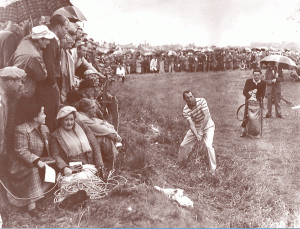 By Mike Stevens, USGTF Teaching Professional Tampa, Florida
By Mike Stevens, USGTF Teaching Professional Tampa, Florida
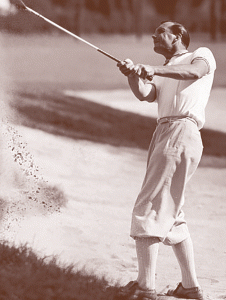 Here is where the story gets even more interesting. After a brief respite, Max headed for the first tee. As he walked, a young boy approached and asked him to sign a ball, but Faulkner was reluctant, not wanting to be distracted. Then the boy said, “You’re going to win,” and at the urging of the boy’s father who mentioned how much it would mean to the boy, Max signed the ball – Max Faulkner, Open Champion 1951. For the first time, he let the thought of blowing a big lead enter his mind, and struggled a bit coming home in 74. There were no scoreboards at the time, so runners were dispatched to and from to let people know what was going on with players still on the course. Word came in that Tony Cerda had turned in 34 and was a threat to catch the leader. A bit later, the word was that three fours on the final holes would tie Faulkner. A final messenger approached Max and related to him, “Cerda’s taken six; it’s your Open.”His dream had proved true – he was the Champion Golfer of the Year. The Claret Jug held by South African Bobby Locke would be returning to Britain.
Here is where the story gets even more interesting. After a brief respite, Max headed for the first tee. As he walked, a young boy approached and asked him to sign a ball, but Faulkner was reluctant, not wanting to be distracted. Then the boy said, “You’re going to win,” and at the urging of the boy’s father who mentioned how much it would mean to the boy, Max signed the ball – Max Faulkner, Open Champion 1951. For the first time, he let the thought of blowing a big lead enter his mind, and struggled a bit coming home in 74. There were no scoreboards at the time, so runners were dispatched to and from to let people know what was going on with players still on the course. Word came in that Tony Cerda had turned in 34 and was a threat to catch the leader. A bit later, the word was that three fours on the final holes would tie Faulkner. A final messenger approached Max and related to him, “Cerda’s taken six; it’s your Open.”His dream had proved true – he was the Champion Golfer of the Year. The Claret Jug held by South African Bobby Locke would be returning to Britain.
